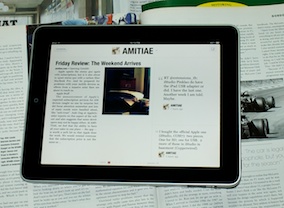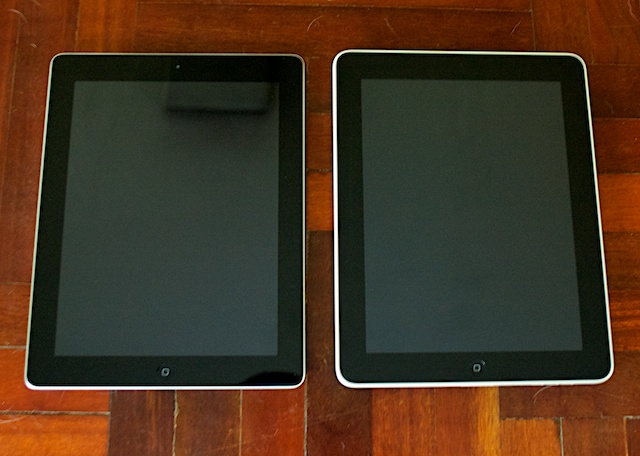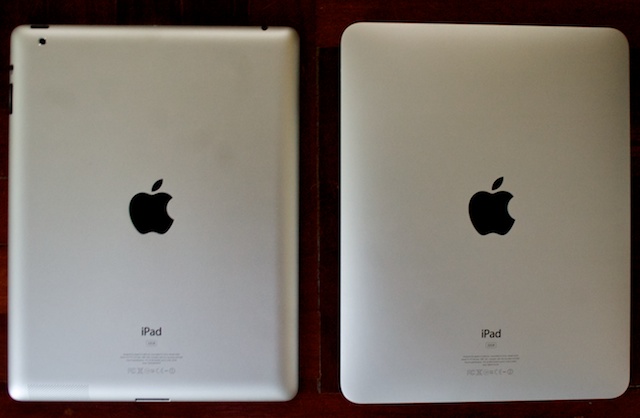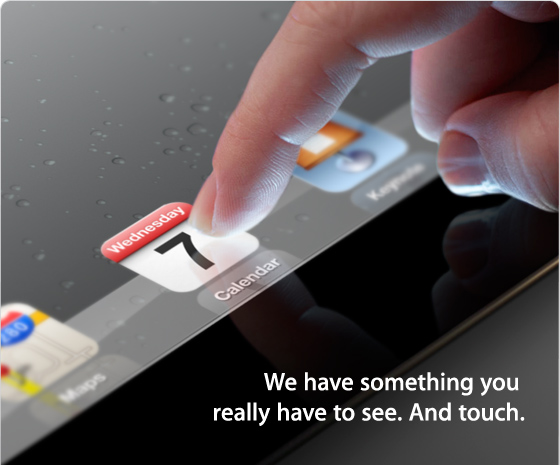Expectations for the iPad 3

AMITIAE - Sunday 4 March 2012
|
Expectations for the iPad 3 |
 |
|
|
By Graham K. Rogers
There is no point otherwise of course.
iPad Arrival The iPad was never a product born in isolation. It used hints from the hardware design of the iPhone, itself improved over a number of generations. Where the iPad made the biggest score, was with the operating system and the set of ready-made apps that had been developed for the iPhone. At its release, there were already a number of apps that had been optimised for the device. Those that were not, would run in a double iPhone size screen: not tidy but it worked.
The iPad was never a product born in isolation. It used hints from the hardware design of the iPhone, itself improved over a number of generations. Where the iPad made the biggest score, was with the operating system and the set of ready-made apps that had been developed for the iPhone. At its release, there were already a number of apps that had been optimised for the device. Those that were not, would run in a double iPhone size screen: not tidy but it worked.
Apple entered a market that had seen so many false starts, with tablet computers having produced by major manufacturers for a number of years before the iPad. Not one was a hit. The iPad immediately became a hot, desirable product starting a scramble by other device makers to come up with their own challengers. Thus far, not one has matched the iPad 1. We are looking forward to iPad3 this week. What so many other manufacturers failed to factor in was the iPad environment. A complete ecosystem had evolved round the iPhone -- itself only reaching a true maturity by the third generation. The infrastructure was already in place, integrated and ready to roll. Most other pretenders to the crown could only rely on a third-party operating system and these reacted mainly after the iPad was introduced so were always destined to play catch-up. These systems were also never optimized for the specific device. We may see such optimizations in the future with Windows on the Nokia and Android on Motorola, although all of the companies are denying that anything like this will happen. Some other handset makers are not totally convinced, particularly with the comments of executives from the OS makers. Those optimizations, however, may be aimed mainly at the smartphone and not at the tablet, but will be seen in a negative light especially by legislators in the US and EU. Two significant exceptions to this generic approach were the BlackBerry Playbook and the HP Touchpad. It was a disappointment to many that the HP device failed to generate more success. Its final failure may have been due more to poor corporate decision-making than to any weakness on the part of the product and its leap in sales once the price was reduced in a fire-sale was both encouraging and saddening. The BlackBerry device may have been rushed out, despite denials from RIM (if it was all part of a plan, it was an awful plan). Its operating system was unable to meet the demands of users particularly with the need to link it to a BlackBerry phone for email and other purposes that users of most other tablet computers took for granted. As a pitch to customer loyalty, it failed (apart from in Canada, where with price cuts it has outsold the iPad in recent months).
Another vote of confidence came from Rupert Murdoch. As much as he is reviled by some, he has an excellent eye for the news business. His job is to sell news and if the content is available in paper or can be downloaded in digital format makes not one iota of difference. An early announcement that there would be a newspaper (I use the term loosely), called The Daily, set up as a tablet only organ, starting with the iPad, was a pivotal moment for many. By the time the next iPad was announced there were around 65,000 apps optimised for the iPad available. The content, the apps and iOS, along with Apple's carefully staged rollouts, country by country following the initial mega-announcement saw some 15 million sold in the 9 months it was available in 2010: more than every tablet PC ever sold according to Apple. The iPad had a foothold in education and medical markets and was widely seen in coffee shops where before notebook computers had been the norm. It could not be matched except by one thing: the iPad 2.

iPad 2 and Original iPad
iPad RevisionThe initial release of the iPad came with all the usual superlatives from Apple and derision from detractors. In between, consumers bought the devices in such huge numbers that markets began to shift. This would become more marked with the iPad 2 and the inclusion of the iPad as a major part of the computer business, and one which was replacing traditional computers or other media. In some cases the uses were from the world of fiction: for example, menus and ordering systems became widely used. I had first seen this idea floated in Terry Gilliam's 1985 satire on a future society, BrazilThe most obvious change was to the design with its sloping edges that I did not warm to, especially with the occasional difficulty I had when trying to connect the 30-pin USB cable. Steve Jobs announced that the new iPad was thinner than before at 8.8mm and lighter. It was also more powerful with its dual core A5 processor. Improved graphics were significant, not only for the more sophisticated games that would become available, but for other apps which could take advantage of this.

iPad 2 and Original iPad
In recent years, Apple has upped the specifications but retained the price (or sometimes made this lower) and the iPad 2 cost the same as the iPad 1. That in itself is important and a lesson not always taken in by other manufacturers. Shipping times were also improved and it was available in the US at the end of the following week after the announcement and in many other countries by the end of March. It arrived in my hands on 6 May: Thailand is way down the pecking order for Apple products.
The Shape of Things to ComeWith any anticipated release of an Apple product, the rumour mill shifts into high gear. We have been told that we may expect a faster processor, better cameras, a better display and that the next iPad will be in the shops (at least in the US) by the end of the week.In many ways, external design decisions hinge on what is inside the next version. It is unlikely that Apple will announce an iPad that does not have improved performance. The iPad follows a parallel track to the iPhone and every new release of that has seen a better processor. The most likely processor is expected to be an A6 chip. Code referring to S5L8945X was seen in a developer version of an iPad, although this could just as easily have been an interim processor or the rumoured A5X that was seen by some sources. A step up is likely whichever processor is used. A faster processor could affect battery life, but Apple has been almost obsessed with this in the last couple of years. As this is a selling point, any reduction would be hard to justify to the top echelons within Apple. A battery that keeps the same 10 hour life might have to be larger if the processor consumes more power, but there is little space inside. Components could be removed, moved or redesigned to be smaller. Apple has also been working on battery technology, so the battery itself could be part of a better internal structure. One component that is expected to change is the camera. Many users were not satisfied with the output of the one in the iPad 2, so this could be on the list of redesigned components. Speakers, buttons and switches may already be on the limit as far as miniaturisation is concerned, although one rumour has suggested that the Home button could be replaced. This would lead not only to hardware changes, but to changes in iOS 5.1 which is expected to be announced this week and released by Friday (9 March). An analysis of the invitation suggests that the image has no button and speculates why this might be. I look forward to finding out.

Invitation Image from Jim Dalrymple, The Loop
Some rumours in the last couple of weeks discussed the pricing of the next iPad and suggested that there would be increases in the prices of the iPad 3. That was later dismissed in another rumour. With Apple's recent pricing histories -- the same or even a reduced price for higher specifications -- an increase is not likely. With more factories producing the current iPhones and iPads, with expansion in places like Brazil, Apple may have more products on hand, or in the pipeline, so a faster rollout may happen this time. Like last year, the major countries may be served by the end of the month, I would anticipate some of the smaller markets, like Thailand and Vietnam to see the iPad 3 by the middle to end of April.
CommentSpeculation surrounding Apple and its products can sometimes be wildly uninformed or the product of knee-jerk reaction. There are many senior executives who regret now their dismissal of both the iPhone and the iPad.There has been a close analysis of the invitation to the Event (see above). There was some speculation concerning the Maps app that was shown to the left of the Calendar icon, which shows I-280 and the Cupertino campus, but there was little comment about the Keynote icon to the right. Perhaps there is no meaning above the Location, the date and a presentation. We could analyse such images until we are blue in the face and still come no clearer to a correct answer. Do you notice the whorls on the guy's index finger? . . .
Graham K. Rogers teaches at the Faculty of Engineering, Mahidol University in Thailand. He wrote in the Bangkok Post, Database supplement on IT subjects. For the last seven years of Database he wrote a column on Apple and Macs. |
|

For further information, e-mail to

|

|